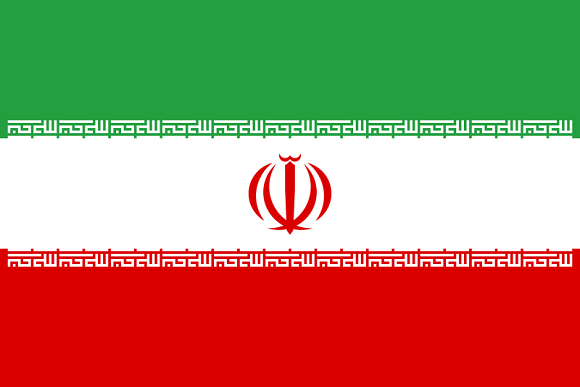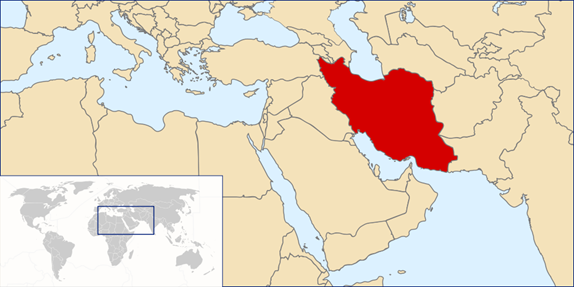
Geography

Source: This image is the intellectual property of Rei-artur. Redistribution under licence CC BY-SA 3.0
Area: 1,648,195 km2 (7,07% water)
Coastline: 2,400 km
Terrain: high rugged mountains across most of the country; high, central basin with deserts, mountains; small, discontinuous plains along both coasts
Highest point: Kuh-e Damavand 5,671 m (to the south of the Caspian Sea)
Climate: mostly arid or semiarid, subtropical along Caspian coast
Geographical population distribution: More than 75% of the population is concentrated in northern, northwestern and western Iran in an area stretching south of the Caspian Sea and west of the country's central basin to the borders with Azerbaijan, Armenia, Turkey, Iraq and ends on the northern coasts of the Persian Gulf.
Natural resources: petroleum, natural gas, coal, chromium, copper, iron ore, lead, manganese, zinc, sulphur
Demographics
Population: ~91,000,000 (2025)
Annual population growth: ~0.9 % (2024 est.)
Estimated population in 2025: ~91,000,000
Age structure (2024)
0‑14 years – 23.3 %
15‑64 years – 69.8 %
65+ years – 7.0 %
Total fertility rate (children per woman): 1.44 (2024 est.)
Birth rate (per 1000 population): 14.3 (2024 est.)
Death rate (per 1000 population): 5.3 (2024 est.)
Median age: ~32.0 years (2025 est.)
Life expectancy at birth: ~75.6 years (2024 est.)
Males – ~74.3 years
Females – ~77.1 years
Net migration rate: ~−0.3 per 1,000 population (2024 est.)
Languages: Persian (official), widely spoken Azerbaijani, Kurdish, Gilaki, Mazanderani, Arabic, Balochi, Turkish, others
Ethnic groups: Persians ~56.6 %, Azerbaijanis ~14.3 %, Kurds ~9.1 %, Gilaki ~5.3 %, Mazanderani ~3.6 %, Arabs ~2 %, Baloch ~2 %, Turks ~2 %, others ~1–1.5 %
Economy
GDP: $203.5 bil (2020)
GDP per capita: $2,422.5 (2020)
GDP annual growth rate: 3.4% (2020)
Public debt (% GDP): 30.67% (2019)
Inflation (CPI): 39.9% (2019)
Unemployment: 11.0% (2020) Imports: $49,900,000,000 (2017)10 largest import partners (% total imports - 2017): China 37%, South Korea 8.1%, Germany 6.5%, Turkey 6.3%, India 5.2%, Brazil 5.1%, Italy 3.9%, France 3.3%, Russia 2.6%, Netherlands 2.4%
Exports: $53,700,000,000 (2017)10 largest export partners (% total exports - 2017): China 31%, India 19%, South Korea 13%, Italy 6.5%, Japan 6%, France 4.4%, Spain 3%, Turkey 2.6%, Greece 2.4%, Singapore 1.3%
Global Competitiveness Report (World Economic Forum)53.0/100 (2019 – position 90/141)
Index of Economic Freedom (Heritage Foundation)47.2/100 ( 2021– position 168/180)
Income Inequality Index (Gini – World Bank)42.0% (2018)
Prosperity Index (Legatum Institute)48.31/100 (2021 – position 123/167)
Military power
Active personnel :550-600,000
Islamic Republic of Iran Regular Forces : 400,000
Ground Forces: 350,000
Navy: 18,000
Air Force/Air Defense Force: 40,000
Islamic Revolutionary Guard Corps: 150-190,000
Ground Forces: 100-150,000
Navy: 20,000
Aerospace Force: 15,00
Qods Force: 5-15,000
Active Basij Paramilitary Forces 90,000 (2021)
Defence expenditure (% GDP): 2.2% (2020)
Politics and Government
Form of government: Theocratic republic
President: Masoud Pezeshkian (since July 28, 2024)
Supreme Leader: Ayatollah Ali Khamenei (since 1989)
Executive branch: The President acts as head of the executive except in matters directly under the authority of the Supreme Leader who is head of state, is appointed for life by the Assembly of Experts and superintends the executive, legislature and judiciary. Members of the Assembly of Experts are clerics who are elected directly by citizens every 8 years. The suitability of a candidate for his first term in the Presidency must be confirmed by the Supreme Leader. Iran’s President is head of the Council of Ministers and is elected directly by the citizens for a 4-year term while he can serve up to two consecutive terms. Ministers are appointed by the President, subject to approval of the Parliament.
Legislative branch: The Islamic Consultative Assembly (or Majles) is the country’s Parliament and it is comprised of 290 members directly elected by citizens for a 4-year term. Five seats are reserved for religious minorities: 2 seats for Armenian Christians, 1 for Assyrian and Chaldean Christians, 1 to Jews and 1 to Zoroastrians. The Majles debates and passes laws while the Council of Guardians may veto a law that does not conform to the Constitution and Islam. The Supreme Leader appoints 6 out of the 12 Islamic jurists that comprise the Council of Guardians while the other 6 are elected by the Majles from a list of jurists nominated by the head of the judiciary.
Judicial branch: The head of the judiciary is appointed by the Supreme Leader for a 5-year term. Iran’s highest court is the Supreme Court while the chief of the Supreme Court as well as the Prosecutor General are both appointed by the head of the judiciary. The High Council of Justice consists of the chief of the Supreme Court, the Prosecutor General and 3 other clergy chosen by religious jurists. The High Council of Justice prepares draft bills related to the judiciary and supervises the appointment of judges among other duties. The court system is divided into civil and criminal courts. There are three basic types of courts: public courts, clerical courts and Revolutionary courts. Public courts are organised into civil courts, special civil courts, first instance criminal courts and second instance criminal courts. There is also an Administrative Court of Justice and a Disciplinary Court for Judges.
Parliamentary parties (seats): There is no firm division of members of Parliament into political parties even though political parties do exist. Representatives in the Majles are generally divided into two political forces: the ‘conservatives’ and the ‘reformists’.
Last elections: Parliamentary elections 2020 – Conservatives 76.20%, Reformists 6.89%, Independents 13.10% (11 undecided seats will be contested in a second round of elections). Voter turnout was 42.57%.Next elections: Parliamentary elections in 2024
Rule of Law - Human Rights
Corruption Perceptions Index (Transparency International)25/100 (2020 - position 149/180)
Rule of Law Index (World Justice Project)
0.43/1 (2020 - position 109/126)
Global Terrorism Index (Institute for Economics & Peace)
4.715/10 (2019 – position 39/163)
Fragile States Index (Fund For Peace)
50.1/120 (2021 – position 137/179)
Democracy Index (Economist Intelligence Unit)
2.20/10 (2020 – position 152/167)
Press Freedom Index (Reporters Without Borders)
68.04/100 (2020 – position 174/180)
Freedom in the World Index (Freedom House)
16/100 (2021)




